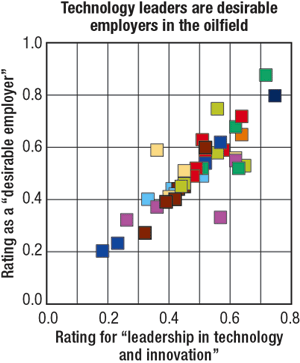Management Issues
Competing for talent in the oil patch
Recent studies provide instruction on E&P employee retention/ recruitment.
Dutch Holland, PhD, and Mike Campbell, PMP, Holland & Davis, Houston
Management leaders’ concerns in the E&P industry have markedly shifted to human resource issues, namely employee recruitment and retention. This contrasts with a historical focus on commodity pricing, capital deployment and operational expertise. This trend is described in Grant Thornton’s latest Survey of U.S. Independent Oil and Gas Companies.It found that 65% of managers expect difficulties in hiring and training employees, up from 20% two years ago.
Further, 95% of firms surveyed anticipate that industry employment levels will increase in 2006, or 32% more than those in 2004. Traditional business practices employed in capital deployment and operating practices – development and tracking of key performance indicators, strategic positioning, and enhancement of operations – can help address recruitment and retention challenges.
With 95% of management teams expecting growth in employment and a finite number of seasoned professionals entering the industry from other businesses, competition for recruiting and retaining employees will remain fierce. Identifying and tracking key drivers that affect employees’ decisions to remain or change employers is crucial.
A recent study by Gulf Research (a joint venture between Gulf Publishing Co., publishers of World Oil, and Gelb Consulting) entitled, Attracting and Retaining Employees in the Oilfield: A Survey of Employer Reputation and Job Satisfaction among Oil and Gas Industry Personnel, found that retention factors for upstream employees are not based solely on issues of compensation.
The Gulf Research study interviewed more than 1,300 employees worldwide. It measured employer reputations of more than 40 different E&P companies, service firms and drilling contractors. In identifying companies that have stronger reputations as employers, the data suggest a strong correlation between a company’s reputation and its role as a “technology and innovation” leader, Fig. 1.
 |
Fig. 1. Gulf Research study on more than 40 employers in the oilfield established a correlation between technology/ innovation readership and a role as a preferred employer.
|
|
Regression analysis further identified the key drivers of job satisfaction and reputation for employers of choice. While the four strongest influences driving employers’ reputations included the statement, “provides competitive compensation,” one of the other crucial drivers was the perception that a company “attracts and retains the best employees.” Therefore, successfully documenting that an employer gains the best and brightest, will help to attract and retain other employees.
The Gulf Research study found that the factor rated the lowest by survey respondents was “employee recognition for work well done.” This factor has been troublesome for employees and employers. Systematically identifying, measuring and tracking these perceptual factors by an employee base can provide the foundation for effective management programs to retain, and attract, employees. The firms with the best reputations on these drivers would have an advantage in today’s competitive talent marketplace.
ACTIONS FOR MANAGEMENT
Besides capturing and measuring data, management should consider action plans that entail the following:
- Invest in initiatives that enhance a firm’s competitive basis. Companies can launch specific initiatives – comprehensive retention plans for key categories, special compensation strategies and/or tangible recognition programs.
- Invest in a performance management system (PMS). A PMS is “the way a company consistently hires, assigns, trains, directs, provides feedback, and reinforces and rewards employees for on-the-job performance.” Companies that consistently invest in a PMS post top scores on reputation and employee satisfaction.
Conversely, some moves could negatively impact an ability to compete for talent. Three frequently negative moves are:
- A distribution-based performance evaluation system. This is guaranteed to be controversial, stirring negative emotions, frequently when many employees need positive reinforcement/ reassurance.
- A peer review system that pits one employee against another. This can and will happen, if a firm’s “360 assessment” is used for anything other than development (not performance evaluation) exercises.
- A leader who is spring-loaded to the “we don’t do anything right message.” It is one thing to advocate continuous improvement with great urgency. It is another to constantly point to negatives.
The Gulf Research study found that the E&P sub-sector enjoyed the highest employee satisfaction ratings – 77% of employees felt “completely” or “mostly” satisfied with their employers. However, 18% of the operating company sampling, felt “somewhat satisfied,” an alarmingly proportion of potentially wavering employees. 
|
THE AUTHORS
|
| |
Dutch Holland is CEO, and Mike Campbell is a managing director of Holland & Davis LLC, a Houston firm providing advisory services to energy companies for more than 35 years.
|
|
|



